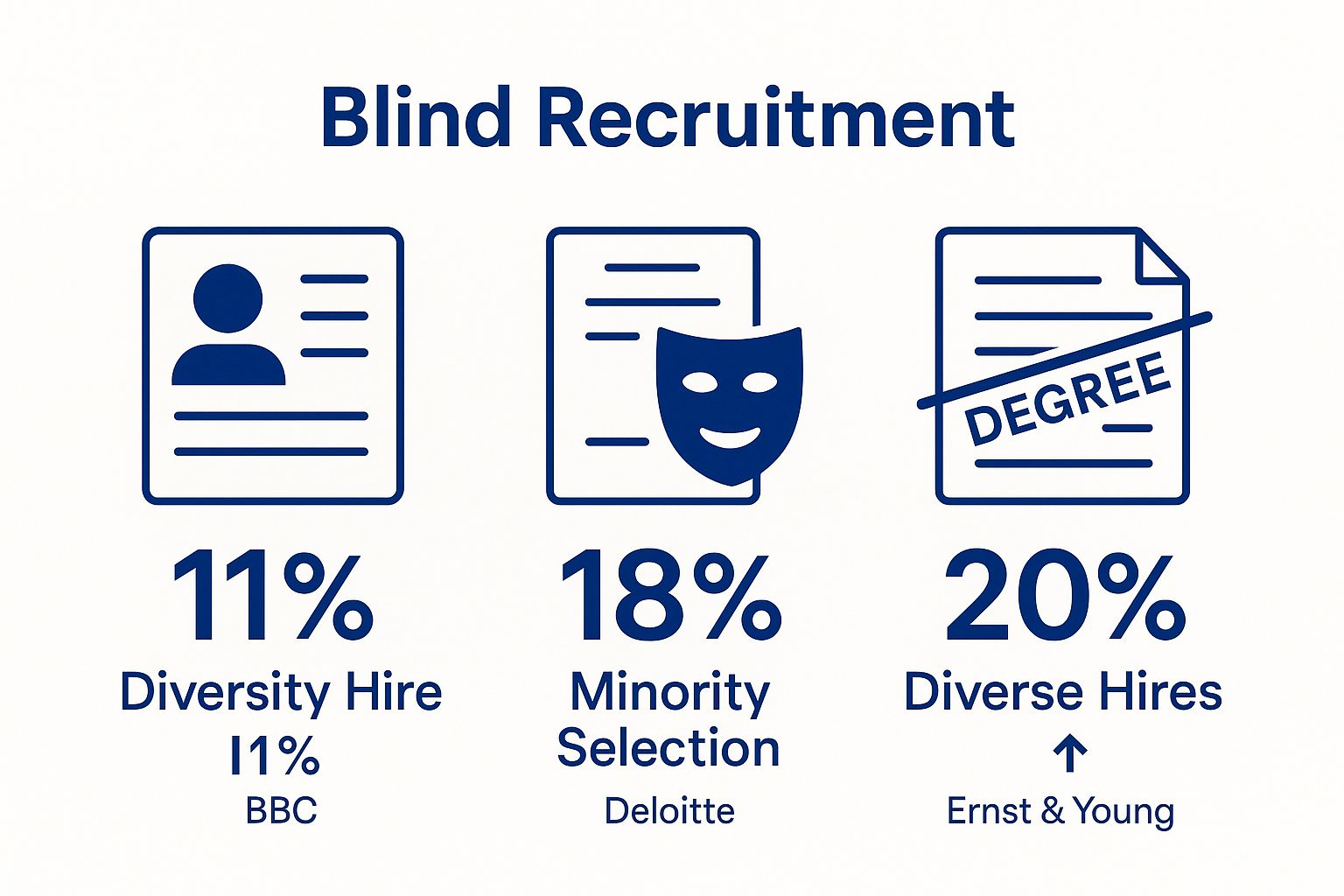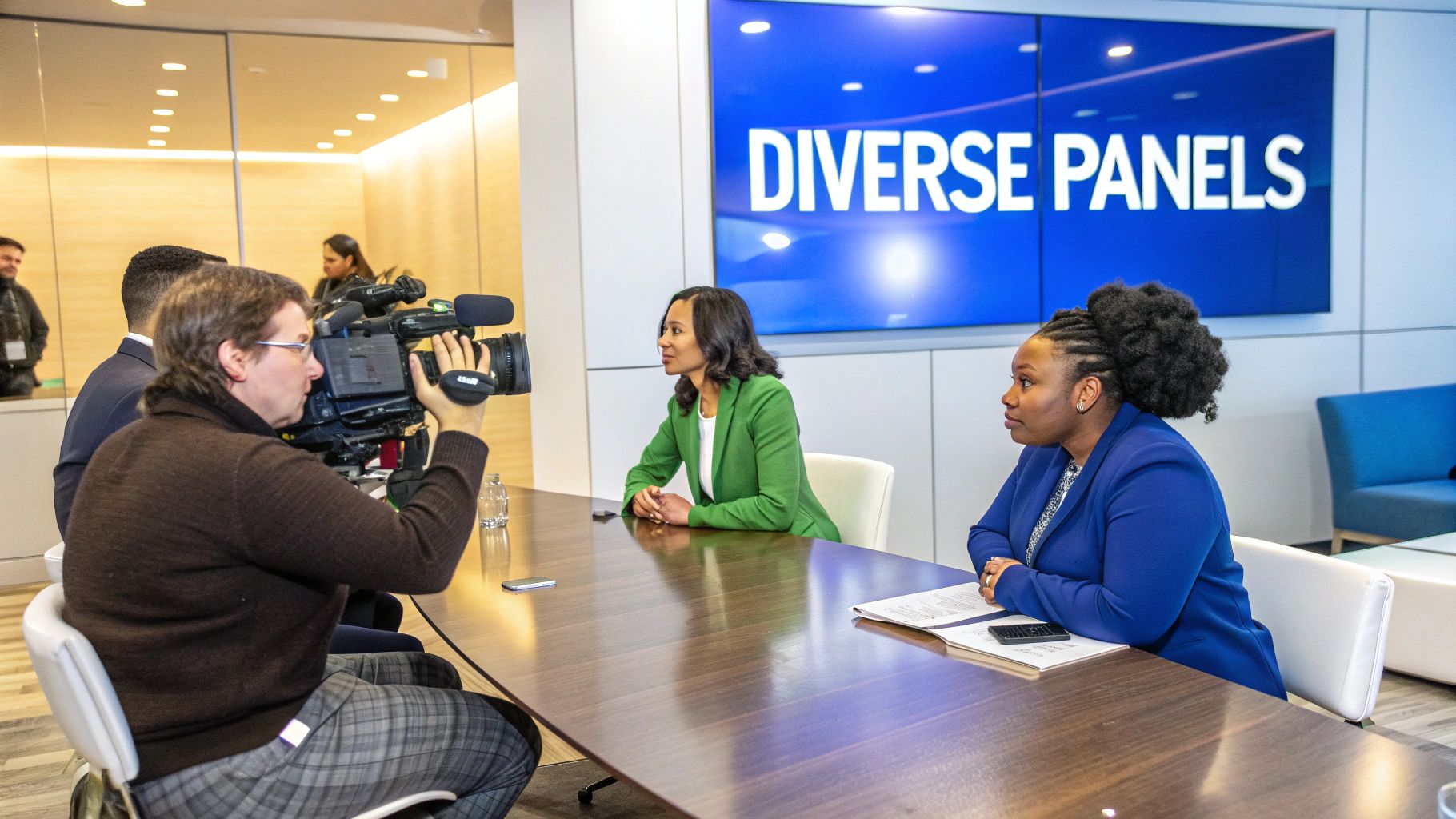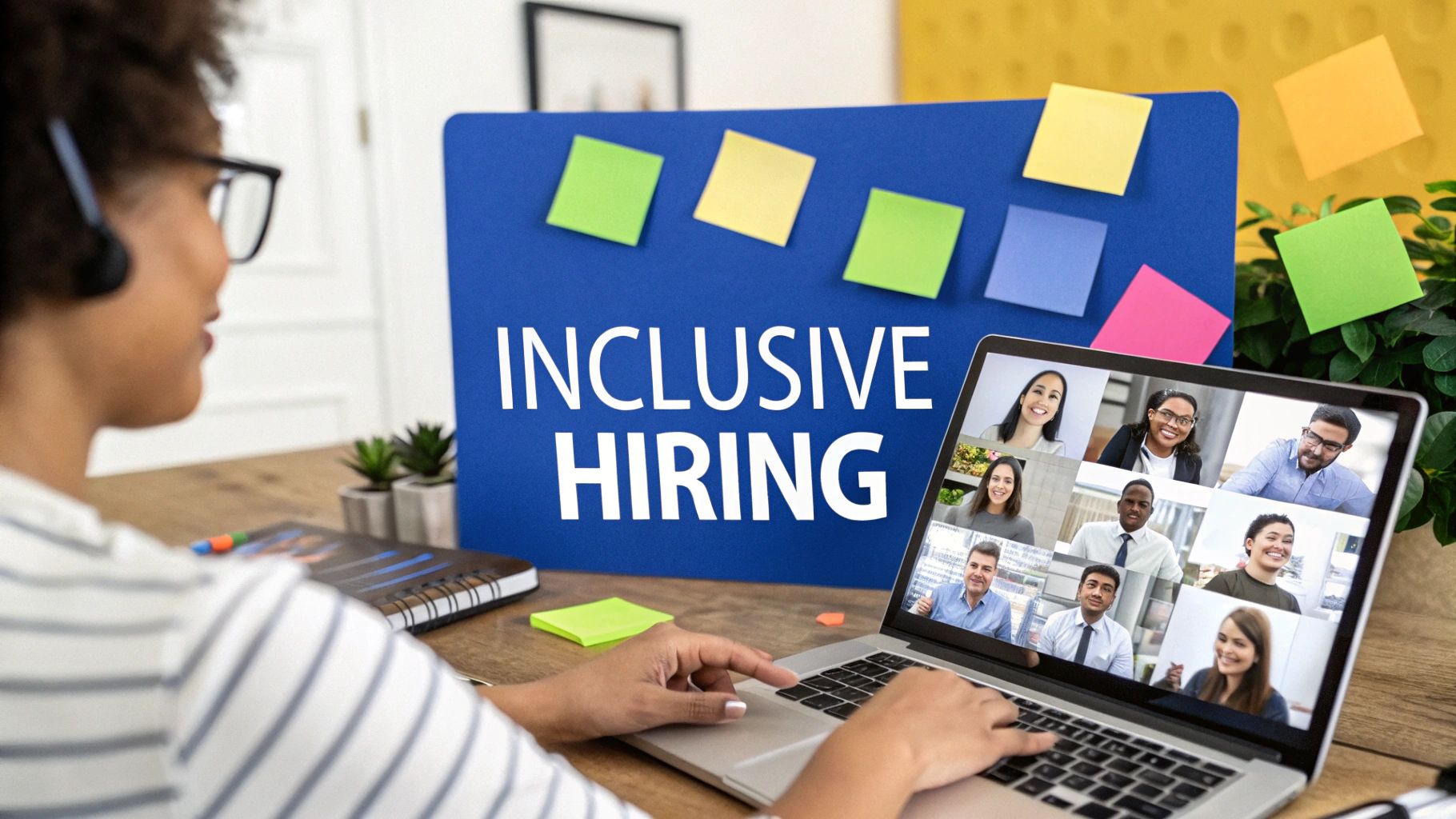In today's global marketplace, building a diverse team is no longer a 'nice-to-have' - it's a fundamental driver of innovation, resilience, and financial performance. For small-to-medium businesses (SMBs) and accounting firms, embracing diversity isn't just about social responsibility; it's a powerful competitive advantage. A variety of perspectives can unlock new solutions to complex problems, improve decision-making, and better reflect an increasingly diverse client base, which is crucial for growth.
Despite good intentions, many organisations find their talent pools remain stubbornly homogeneous. This is particularly challenging in a remote-first world, where traditional recruitment methods may inadvertently reinforce existing biases rather than dismantle them. Moving from aspiration to tangible results requires a structured approach. The key lies in implementing deliberate and actionable diversity hiring strategies that actively dismantle systemic bias and open doors to underrepresented talent.
This guide moves beyond generic advice to provide a detailed roundup of eight proven strategies you can implement immediately to build a more inclusive, high-performing remote workforce. We will explore practical steps, specific examples, and unique angles to transform your recruitment process from the ground up, ensuring you attract and retain the best talent from every background. From blind recruitment and structured interviews to data-driven tracking and inclusive employer branding, you will gain the tools needed to make meaningful, sustainable change.
1. Blind Recruitment
Blind recruitment is one of the most direct and impactful diversity hiring strategies available, designed specifically to combat unconscious bias at the critical first stage of the hiring process. This technique involves anonymising candidate applications by removing personal identifiers such as names, gender, age, photographs, and even the names of educational institutions. The core principle is to force evaluators to focus exclusively on a candidate's skills, experience, and qualifications, ensuring a more objective and merit-based initial screening.
By stripping away information that can trigger unconscious assumptions, businesses create a level playing field where talent is the only metric that matters. This is especially crucial for small to medium-sized businesses and accounting firms that may lack extensive HR resources to conduct in-depth bias training. Implementing a blind review process is a structural change that promotes fairness systematically.
How to Implement Blind Recruitment
Making this strategy a reality in your organisation is more straightforward than it may seem. It requires a structured approach and clear guidelines for your hiring team.
- Utilise Technology: Leverage an Applicant Tracking System (ATS) with a "blind hiring" or "anonymisation" feature. These tools can automatically hide specified fields from candidate profiles and CVs.
- Standardise Applications: Instead of relying on open-ended CVs, use standardised application forms that focus on specific skills, competencies, and experience relevant to the job.
- Focus on Skills-Based Assessments: For technical roles, such as bookkeepers or financial analysts, implement blind skills tests or coding challenges where performance is the sole indicator of capability.
- Train Your Team: Educate hiring managers and interviewers on the principles of objective evaluation. Provide them with a clear scoring rubric based on the essential skills and requirements outlined in the job description.
The following infographic highlights the proven success of blind recruitment in increasing diversity across various industries.

These figures demonstrate that removing identifying information is a powerful mechanism for expanding the diversity of your candidate pool and selection outcomes.
For a deeper dive into the science behind unconscious bias and how blind processes can counteract it, the video below provides valuable insights.
2. Diverse Hiring Panels
Establishing diverse hiring panels is a powerful and proactive diversity hiring strategy that institutionalises fairness directly into the interview stage. This approach involves assembling an interview committee with individuals from different backgrounds, departments, demographics, and levels of seniority. The fundamental goal is to mitigate the impact of any single person's unconscious bias by introducing a variety of perspectives into the candidate evaluation process.
A single interviewer, no matter how well-intentioned, views a candidate through a limited lens shaped by their own experiences. A diverse panel, however, ensures a more holistic and balanced assessment. This method is particularly effective for small to medium-sized businesses and accounting firms, as it leverages existing team members to create a more robust and equitable evaluation system without requiring significant financial investment.

This collective decision-making process naturally challenges affinity bias-the tendency to favour people who are similar to us-and promotes a culture of collaborative, merit-based hiring. Tech giants have successfully pioneered this approach; Google requires diverse panels for senior roles, and Intel’s mandate for them contributed to a 40% increase in diverse representation.
How to Implement Diverse Hiring Panels
Putting diverse panels into practice requires thoughtful planning and clear guidelines to ensure the process is consistent and effective. It's about more than just gathering different people in a room; it's about structuring their collaboration.
- Establish Panel Requirements: Define minimum diversity criteria for your interview panels. This could mean including at least one woman, one person from an underrepresented ethnic group, or someone from a different department.
- Train All Panel Members: Equip everyone on the panel with training on unconscious bias, structured interviewing techniques, and the importance of focusing on job-related competencies. This ensures all interviewers are aligned on the goal of objective evaluation.
- Use Structured Interview Guides: Provide all panellists with a standardised set of questions and a scoring rubric. This forces a consistent evaluation framework across all candidates, making comparisons fairer and more data-driven.
- Document the Rationale: Require the panel to collectively document the reasoning behind their hiring decision. This creates transparency and accountability, ensuring that the final choice is clearly tied to the skills and qualifications required for the role.
3. Inclusive Job Descriptions
Crafting job descriptions that resonate with a wide array of candidates is a fundamental pillar of effective diversity hiring strategies. This approach goes beyond simply listing duties; it involves a conscious effort to use inclusive language, remove unnecessary barriers, and accurately represent your company culture. The goal is to create a welcoming first impression that encourages talented individuals from all backgrounds to apply, rather than unintentionally deterring them.
By carefully auditing the words you use, you can eliminate subtle biases that may discourage qualified women, older professionals, or individuals from underrepresented groups. Research shows that certain phrases and excessive requirements can disproportionately filter out diverse talent before they even hit "apply". For small businesses and accounting firms, where every hire has a significant impact, ensuring your job descriptions are inviting and equitable is a low-cost, high-impact way to broaden your talent pool.

How to Implement Inclusive Job Descriptions
Transforming your job postings into powerful tools for diversity requires attention to detail and a focus on what truly matters for the role. This strategic shift ensures you attract candidates based on capability, not conformity.
- Audit Your Language: Use tools like Textio or the Gender Decoder to analyse your job descriptions for gender-coded words (e.g., "rockstar," "dominant") and replace them with neutral alternatives (e.g., "skilled," "dedicated").
- Focus on Outcomes, Not Attributes: Instead of listing vague personality traits, describe the key outcomes the successful candidate will be expected to achieve. For example, rather than asking for a "go-getter," state, "Develop and execute three new client acquisition campaigns per quarter."
- Distinguish 'Must-Haves' from 'Nice-to-Haves': Critically evaluate every requirement. Remove qualifications, such as specific degree requirements or arbitrary years of experience, that are not essential for performing the job. This opens the door to skilled candidates from non-traditional backgrounds.
- Highlight Inclusivity and Flexibility: Explicitly state your commitment to diversity and inclusion. Mention benefits that appeal to a diverse workforce, such as flexible working hours, remote work options, and comprehensive parental leave.
The success of this strategy is well-documented. For instance, Unilever saw a 73% increase in diverse hires after removing degree requirements for most roles, while Buffer experienced a 42% rise in female applicants after rewriting its job descriptions with inclusive language. These examples show that the language you use directly impacts the diversity of your applicant pipeline.
4. University and Community Partnerships
Forging strategic collaborations with diverse educational institutions and community groups is one of the most proactive diversity hiring strategies a business can adopt. This approach involves building long-term, meaningful relationships with organisations that serve underrepresented talent, such as Historically Black Colleges and Universities (HBCUs), Hispanic-Serving Institutions (HSIs), women's colleges, and local community organisations. The goal is to move beyond passive job postings and create a direct, sustainable pipeline of diverse candidates.
By investing in these partnerships, your business gains early access to emerging talent and builds a positive brand reputation within these communities. This method is particularly effective for creating pathways into specialised fields like accounting and finance, where specific skills are paramount. For example, Goldman Sachs' dedicated university partnerships have led to intern classes that are over 40% diverse, showcasing the power of this focused approach.

How to Implement University and Community Partnerships
Building these relationships requires genuine commitment and a long-term vision. It's about being a partner, not just a recruiter.
- Establish Multi-Year Agreements: Go beyond one-off career fair visits. Create multi-year partnership agreements that outline mutual goals, such as curriculum collaboration, guest lectures from your senior leaders, and dedicated recruitment events.
- Provide Meaningful Internships: Design structured internship programmes that offer real-world experience, not just administrative tasks. Ensure interns work on impactful projects and are integrated into your company culture, making them more likely to accept full-time offers.
- Offer Mentorship Programmes: Connect students with senior employees who can provide career guidance and support. This helps demystify the corporate world and builds a strong connection between the student and your organisation long before graduation.
- Create Scholarship and Sponsorship Programmes: Fund scholarships or sponsor campus events to demonstrate a tangible investment in the students' success. This elevates your company's profile and shows you are serious about supporting their educational journey.
This strategy is about cultivating talent, not just sourcing it. As demonstrated by Procter & Gamble, whose HBCU partnerships helped increase its Black leadership ranks by 50%, the long-term return on these relationships is a more diverse, innovative, and representative workforce at all levels of the organisation.
5. Employee Referral Diversity Programs
Traditional employee referral programmes, while effective for sourcing candidates, often perpetuate a homogenous workforce by tapping into existing, non-diverse networks. An enhanced referral system is one of the most powerful diversity hiring strategies because it consciously works against this trend. This approach involves incentivising and actively encouraging employees to refer candidates from underrepresented backgrounds, transforming a standard recruitment channel into a proactive tool for building a more diverse team.
The core principle is to leverage your current employees' networks in a more targeted way. Instead of just asking for "good people," you guide and reward them for connecting the company with qualified individuals from diverse communities. This strategy is particularly effective for small to medium-sized businesses and accounting firms, as it harnesses existing resources to achieve significant diversity goals without a massive budget. For instance, Salesforce saw a 33% increase in hires from underrepresented groups after launching its own diverse referral programme.
How to Implement Employee Referral Diversity Programmes
Activating this strategy requires more than just announcing a new policy; it needs a structured, educational, and incentivised framework to succeed.
- Offer Enhanced Incentives: Provide a higher referral bonus for successfully hired candidates from underrepresented groups. This "diversity bonus" signals the organisation's commitment and motivates employees to look beyond their immediate, often homogenous, circles. Accenture, for example, saw a 25% increase in diverse candidates through this method.
- Educate and Empower: Train your employees on the value of diversity and how unconscious bias can influence their referral choices. Provide them with resources and talking points to help them reach out to their wider networks effectively.
- Launch Targeted Campaigns: Partner with your Employee Resource Groups (ERGs) to run specific referral campaigns. A campaign focused on referring women in tech, led by your women's ERG, can yield remarkable results, similar to how Pinterest doubled its female engineering hires.
- Track and Analyse: Implement a system to track the diversity of referred candidates and hires. Regularly review these metrics to understand what’s working and where you need to adjust your approach.
By making your referral programme more intentional, you not only improve diversity metrics but also boost employee engagement and strengthen your company culture. These programmes are also a key component in retaining the diverse talent you work so hard to hire. You can learn more about how diversity and engagement impact employee retention on beyondhire.co.
6. Structured Behavioural Interviews
Structured behavioural interviews represent a systematic and highly effective diversity hiring strategy that shifts the focus from gut feelings to evidence-based assessment. This method involves asking all candidates the same set of predetermined questions designed to probe past behaviours in specific work-related situations. The principle is that past performance is the best predictor of future performance, allowing for a fair and consistent evaluation process.
By standardising the questions and using a consistent scoring rubric, this approach minimises the impact of interviewer bias. It prevents interviewers from asking subjective or off-the-cuff questions that can lead to snap judgements based on affinity or stereotypes. For small businesses and accounting firms, this creates a more defensible and equitable hiring process, ensuring every candidate is judged on their actual competencies and experience, not on how well they connect with an interviewer on a personal level.
How to Implement Structured Behavioural Interviews
Putting this strategy into practice requires careful preparation and commitment from your hiring team to ensure fairness and consistency across all interviews.
- Develop Competency-Based Questions: Create questions directly linked to the core competencies required for the job. For an accounting role, this might involve questions about handling a difficult client, identifying a financial discrepancy, or managing tight deadlines.
- Train Your Interviewers: All interviewers must be trained on how to conduct the interview, use the scoring rubric consistently, and avoid leading questions. Role-playing and calibration sessions are crucial to align the entire team.
- Use the STAR Method for Evaluation: Train interviewers to listen for and evaluate answers based on the STAR method: Situation (the context), Task (what they needed to achieve), Action (what they did), and Result (the outcome).
- Document Everything: Maintain detailed notes and scores for each candidate's responses. This documentation provides a clear, evidence-based rationale for hiring decisions, which is vital for compliance and fairness.
Companies like Amazon have successfully used this method to build diverse leadership teams, while Johnson & Johnson's approach to structured interviews has demonstrably improved diverse hiring outcomes. This proves that a well-organised, structured process is a powerful tool for building a more inclusive workforce.
For additional insights on creating a more systematic and effective hiring journey, you can explore this resource on an efficient hiring process. Learn more about optimising your hiring process on beyondhire.co.
7. Inclusive Employer Branding
Inclusive employer branding is a powerful long-term strategy that goes beyond individual job adverts. It involves strategically shaping your company's public image to reflect a genuine commitment to diversity, equity, and inclusion. This approach uses authentic storytelling and transparent communication to attract candidates from all backgrounds who are seeking a workplace where they can truly belong and thrive. By showcasing your values in action, you build a reputation as an employer of choice for diverse talent.
This is one of the most proactive diversity hiring strategies because it builds a pipeline of interested candidates before a vacancy even exists. For small businesses and accounting firms, a strong, inclusive brand can be a significant competitive advantage, helping you attract top talent that might otherwise be drawn to larger corporations. It signals that your organisation is a place where different perspectives are not just welcomed but are considered essential to success.
How to Implement Inclusive Employer Branding
Building an authentic and inclusive brand requires consistency and a commitment to transparency. It's about showing, not just telling, what your company culture is truly like.
- Feature Real Employee Stories: Move beyond stock photos. Share authentic testimonials, day-in-the-life videos, and blog posts from your current employees. Let them share their experiences in their own words, highlighting what makes your company culture inclusive for them.
- Use Diverse Imagery: Ensure all your recruitment materials, from your careers page to social media posts and job adverts, feature a wide range of people representing different genders, ethnicities, ages, and abilities. This visual representation is a powerful first impression.
- Share Diversity Metrics and Goals: Transparency builds trust. Publish your company's diversity data, acknowledge areas for improvement, and clearly state your goals for the future. This shows a genuine commitment to progress. For example, Starbucks has seen a 45% increase in minority applications by transparently sharing partner stories and diversity initiatives.
- Highlight Inclusive Benefits: Actively promote policies that support a diverse workforce. This includes flexible working hours, comprehensive parental leave, mental health support, and employee resource groups (ERGs). Make these benefits a central part of your employer value proposition.
- Ensure Social Media Reflects Your Values: Your social media channels are a window into your company culture. Actively engage in conversations about diversity and inclusion, celebrate heritage months, and share content that aligns with your inclusive values.
The following case study illustrates the impact of a strong, purpose-driven brand on attracting diverse talent.
Case Study: Patagonia's Activist BrandPatagonia has built its entire brand around environmental and social activism. This clear, unwavering stance attracts a diverse pool of candidates who are passionate about these causes and share the company's core values. Their branding isn't a marketing gimmick; it's an authentic reflection of their corporate mission, which resonates deeply with purpose-driven individuals from all walks of life.
By embedding inclusivity into the very fabric of your brand, you create a magnetic pull for the diverse talent essential for innovation and growth in today's market.
8. Data-Driven Diversity Tracking
What gets measured gets managed, and this is especially true for building a diverse workforce. Data-driven diversity tracking is a powerful strategy that involves the systematic collection, analysis, and application of diversity metrics throughout the entire hiring process. By treating diversity and inclusion as a core business objective, organisations can move beyond guesswork and make informed, impactful decisions.
This approach transforms diversity from a vague aspiration into a measurable goal. It allows businesses, particularly small to medium-sized enterprises and accounting firms, to pinpoint exactly where their hiring funnel may have biases or barriers. For example, you might discover a high volume of diverse applicants but a significant drop-off after the first interview stage, indicating a need for interviewer bias training. Using data provides the clarity needed to apply resources effectively and track progress over time.
How to Implement Data-Driven Diversity Tracking
Putting this strategy into practice requires a commitment to collecting and interpreting data consistently. It’s about building a system that provides continuous feedback on your diversity hiring strategies.
- Track the Full Funnel: Collect anonymous, self-reported demographic data at every stage of the hiring process: application, screening, interview, offer, and hire. This reveals where different groups of candidates are dropping out.
- Leverage Your ATS: Use an Applicant Tracking System (ATS) with robust analytics and reporting features. Configure it to generate regular, easy-to-understand reports on your diversity metrics.
- Set Clear, Realistic Goals: Based on your initial data, establish specific, measurable, achievable, relevant, and time-bound (SMART) diversity targets. For instance, aim to increase the percentage of women in technical roles by 10% within a year.
- Promote Transparency: Share your diversity data and progress towards goals with your team and key stakeholders. Transparency builds accountability and reinforces the organisation's commitment to change. Notable examples include Intel's investment, which led to achieving full representation, and Slack's public diversity dashboard.
Integrating these metrics is a crucial component of effective human resource planning. For a deeper understanding of how data can inform your broader talent strategy, you can explore more about human resource planning on beyondhire.co.
Diversity Hiring Strategies Comparison
Turning Strategy into a Sustainable Reality
Implementing effective diversity hiring strategies is not a checkbox exercise or a one-off project. It is a fundamental, ongoing commitment to reshaping your organisation’s culture, unlocking innovation, and building a workforce that truly reflects the world we live in. The eight strategies we have explored, from blind recruitment and inclusive job descriptions to structured interviews and data-driven analysis, provide a comprehensive and actionable framework. They are the essential building blocks for any small or medium-sized enterprise (SME) or accounting firm ready to move beyond good intentions and achieve tangible results.
However, the true power of these strategies is realised only when they are woven together into a cohesive, organisation-wide effort. Adopting structured behavioural interviews is a crucial step, but its impact is multiplied when supported by a diverse hiring panel and an inclusive employer brand that attracts a wider range of candidates in the first place. Similarly, tracking diversity data is essential, but it becomes transformative when the insights are used to refine your community partnerships and referral programmes. This interconnectedness is key; individual tactics are helpful, but a holistic strategy is what creates lasting change.
From Blueprint to Business as Usual
The journey from a list of tactics to a sustainable, inclusive culture requires dedication and a clear action plan. The most significant barrier is often inertia. To overcome this, focus on implementing one or two key changes immediately.
Your Actionable Next Steps:
- Conduct an Immediate Audit: Start with your job descriptions. Review three to five current or recent job adverts using an inclusive language tool. This is a low-cost, high-impact action that can be completed this week.
- Assemble a Pilot Team: Identify a small group of passionate employees from different departments and levels to form a pilot "Diversity Hiring Task Force". Task them with reviewing your current interview process against the structured behavioural interview model.
- Schedule a Leadership Discussion: Present the business case for diversity, focusing on innovation, problem-solving, and market access. Secure their explicit buy-in to champion these initiatives from the top down.
Remember, the goal is not perfection overnight, but persistent, incremental progress. Each step, no matter how small, contributes to building a more equitable and robust recruitment process.
Key Takeaway: The most successful diversity initiatives are not siloed within HR. They are integrated across the business, championed by leadership, and owned by every team member involved in the hiring process.
The True Value of a Diverse Workforce
Mastering these diversity hiring strategies is about much more than compliance or public perception. It is a strategic imperative for long-term success, especially for agile SMEs and specialised accounting firms. A diverse team, particularly in a remote setting, brings a multiplicity of perspectives that leads to better decision-making, more creative problem-solving, and a deeper understanding of a global customer base. It enhances your employer brand, making you a magnet for top talent who increasingly prioritise inclusive workplaces. Ultimately, it builds organisational resilience.
This journey requires commitment, but you do not have to walk it alone. For businesses looking to accelerate their progress and access a pre-vetted, diverse talent pool, strategic partnerships can be a game-changer. Beyond Hire, for example, specialises in connecting UK companies with the top 1% of remote finance and accounting professionals from South Africa. This model inherently diversifies your talent pipeline while ensuring technical excellence and cultural alignment, bypassing many of the initial hurdles of building a diverse workforce from scratch.
By embracing the diversity hiring strategies outlined in this guide, and considering specialised partnerships to augment your efforts, you can transform your recruitment goals from a distant vision into a measurable, sustainable reality. You will be building more than just a diverse team; you will be cultivating an environment where innovation thrives, employees feel a true sense of belonging, and your business is positioned for enduring growth and success.

